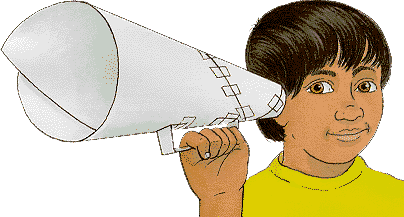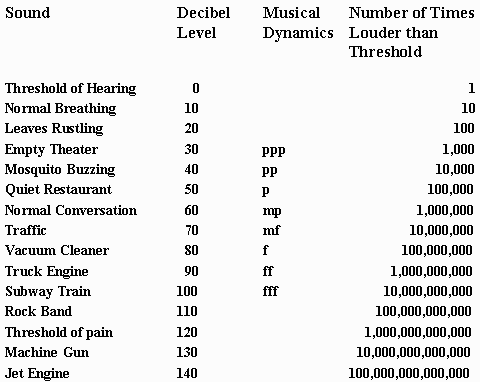


| Title: | Location | K-4 | 5-8 | 9-12 | Description | Discipline |
| Loudness | SoundGarden | How loud or soft can you hear? |
TIP: you will need to use the speakers on your multimedia computer to properly hear these effects. Make sure the volume isn't too loud!
Play the following music example over the speakers on your computer. As the sound plays, try cupping your hand around, not over, your ear. Does the sound get softer or louder?
Now try playing the same music example again but try using only one hand. Next try different shapes with one or both hands. Which one makes the sound loudest? Can you explain why? Write your explanation down in your journal.
If anyone gives you grief about making too much noise, just smile and politely tell them that you are undertaking very important scientific experiments. [ You may need to turn the master volume down on your computer. ]
Hands-On! Activity
Hear! Hear! Make Your Own Ear Trumpet

Materials Needed:
- 3-4 sheets of 8.5" x 11" paper
- roll of tape
- a pair of scissors
To Do:
- Roll your paper into a cone, so the opening is about 2 inches. [ Don't stab your ear with the cone, just rest it on the opening. ]
- Tape the edges of the paper so the cone doesn't come apart.
- Cut out and tape a handle [ this step is optional ].
 (36") – listen to this with your ear trumpet pointing at the speakers.
(36") – listen to this with your ear trumpet pointing at the speakers.- Once the music begins, slowly move your head and the cone away, then towards the speakers.
- Now let's make another bigger ear trumpet. Tape two pieces of paper together, then roll it into a BIG cone.
 (36") – listen to this with your ear trumpet. Is it louder or softer this time?
(36") – listen to this with your ear trumpet. Is it louder or softer this time?- Next, use a pair of scissors cut the first ear trumpet in half, making it smaller. (You can just tear it if you don't have scissors).
 (36") – listen to this with your ear trumpet. Is it louder or softer this time?
(36") – listen to this with your ear trumpet. Is it louder or softer this time?
What happens? In which position is the music loudest or softest?
TIP: you can enhance the effect by gently using a finger to cover you other ear. Also, listen to the music with the different sized ear trumpets at three different volume levels – soft, medium, and loud.
What changes? What doesn't change? Write your ideas down in your journal.
What's happening?
The ear trumpet gathers and focuses the sound waves from the air into your ear. The bigger the guide-end the more sound energy it gathers, the smaller the ear-end the more the sound waves are focused.

A tool similar to this was used as one of the first hearing aids.
What's the point?
If you've worked through the previous sound examples, you should have a sense that sound intensity covers a large range.
In fact, your ears are so sensitive to loudness that their range spans over one trillion units of measure (called decibels, abbreviated dB)! That's a 1 and twelve 0's! Check it out on the chart below.

Human Hearing Range for Loudness
Did you know that your ear is also sensitive to small changes in loudness? There's a range called the just noticeable difference that covers the smallest increase in loudness people can hear. It's very small, about .2 to .4 decibels.
Just for Fun!
What are some musical ways to describe loudness (sound intensity)?
Did you also notice where the range of standard musical notation for loudness fits on the chart above? The 'p' stands for the term piano (which means soft in Italian), and 'f' stands for forte (which means loud). Do you know what the 'm' stands for (hint: look up the Italian word 'mezzo')?
Musicians use changes of loudness for a wide array of musical effects. Some of the basics include the crescendo, decrescendo, and sforzando. Also during the Baroque and Classical periods, composers often repeated a loud section of music (forte) with a soft version (piano). The expressive effect is one of contrast or juxtaposition.
What is the loudest sound you ever heard? What is the softest sound you've ever heard? How many sounds in the place where you are right now can you identify as loud, soft, or medium? Write them down in your journal.
Extra credit: write a short story or poem using the different sounds you just identified.
"The soft complaining flute,
In dying notes, discovers,
The woes of hopeless lovers."
– John Dryden
Send your comments to: webteam@cafemuse.com
© 1996 – 2013 NewWorldView, All Rights Reserved.